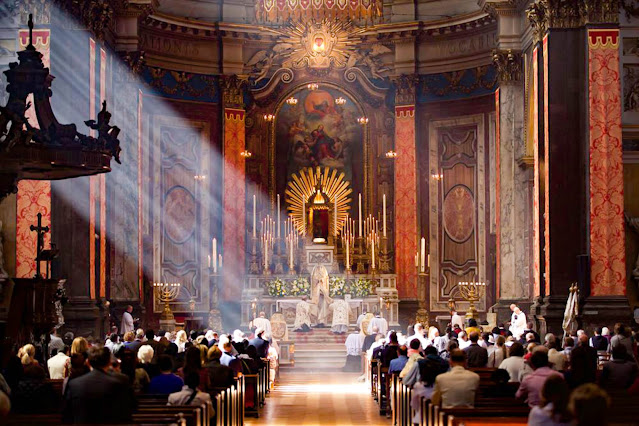This is an excerpt from a longer article from “Adoremus” in December of 2007 at it concerns their celebration of the Holy Sacrifice of the Mass in what was then a few months into the liberation of the Tridentine Mass and the new Mass then called the “Ordinary Form.”
What is so difficult about how the normal, post antecedent Mass can be celebrated if clergy and laity put their minds to it?
…what is currently important about the Oratory is that it offers today’s Catholics a lesson in how the liturgy can and should be celebrated. The Novus Ordo Latin sung Mass every Sunday is packed with regular worshippers of all ages, visitors, inquiring Anglicans, and wistful we-come-when-we-can-and-wish-it-could-be-more-often refugees from parishes across London and the South of England.
The Mass is celebrated facing God. The clergy wear beautiful Roman vestments and birettas. The liturgy follows fully and exactly the rubrics of the Church, complete with incense, genuflections, bowing, and the correct and exact wording of every prayer and Scripture reading. Nothing is altered into feminist language. No substitutes are made for the ritual and gestures prescribed by the Church. There is no "Good morning, everyone and wasn’t that a wonderful result at the football last night?" There is no sudden decision to omit an important prayer or substitute something more chatty and informal. At the Consecration the reverence that sweeps the church is tangible. At the Elevation the bell of the church is tolled to tell London of the mystery enacted in its presence, while the bell at the altar sings out the simultaneous message to the congregation. At Communion, when priests bring the Hosts down to the second Communion rail (there are huge crowds) halfway down the Church, a cascade of genuflections precede them as everyone sinks to their knees in the presence of the Blessed Sacrament. Mass has an unhurried pace. There is a sense that it is worth spending time with God.

3 comments:
"What is so difficult about how the normal, post antecedent Mass can be celebrated if clergy and laity put their minds to it?"
Nothing. Where this conversation becomes challenging to take forward is there is also nothing requiring what is being modeled here to be the norm. Additionally, incense isn't required at mass and neither are birettas (not a vestment). Third, this is simply a style preference; again, not a mandate. Though I do not care for more contemporary worship styles, they too are valid and a style preference for those who gravitate toward them. My point, valid options that are available make this a short conversation.
In the Byzantine Ruthenian Church, we don't have these options so your question, relative to our "Revised Divine Liturgy" of 2008 or, whatever year it was - it's slipped my mind - can easily be answered "Done." as our tradition retains it's organically evolved rubrics and norms. I don't know how you undo what has happened to the Roman Church without alienating many of those who are left. Start with ad orientem, nothing more, would likely go miles toward re-orienting attitudes particularly regarding the true presence. I don't think altar rails preceeding ad orientem will make a significant difference though it likely will to a limited extent.
What the London Oratory did after 1970 was to adapt the Novus Ordo to its existing liturgical and musical traditions, which were renowned for their excellence. With a professional choir and enough clergy to take on the roles required for Solemn Mass and Vespers, it was able to set a standard which few parishes could emulate.
What the Oratorians in London and elsewhere show in their liturgy is that it is possible to celebrate the post-Vatican II rites in continuity with tradition; essential to this is the retention of Latin in celebrations of a more solemn character. I agree with ByzRus that they are not 'modelling' anything, but I would maintain that it represents more than just a 'style preference'.
It should also be remembered that Oratorians are noted as much for their pastoral outreach as for their liturgical and musical excellence.
Incidentally, the photograph shows not Mass, but Solemn Benediction. The exposition throne can be raised or lowered as required.
Post a Comment